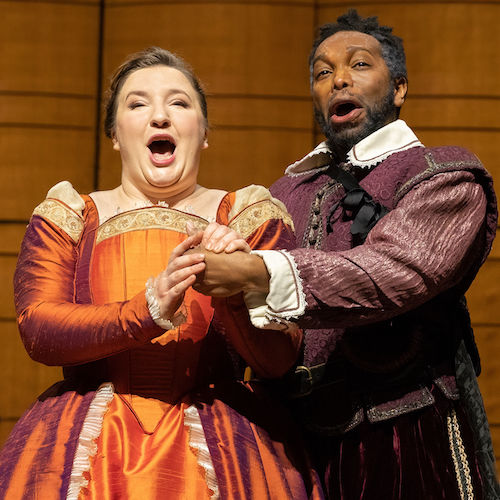Quigley, fine cast illuminate the secular and sacred Pergolesi for Opera Lafayette

Hannah De Priest and Jonathan Woody starred in Pergolesi’s La Servante maîtresse presented by Opera Lafayette. Photo: Jennifer Packard
Opera Lafayette’s 2022-23 season has focused on the world of Madame de Pompadour, the powerful member of the court of Louis XV in the middle years of the 18th century. For Thursday evening’s program in the Kennedy Center Terrace Theater, led by Patrick Dupré Quigley, the company presented two of the seminal works of Italian composer Giovanni Batista Pergolesi, which, despite his untimely death in 1736, served as important cultural touchstones in France around the height of Madame de Pompadour’s influence in the 1750s.
The first half of the evening was devoted to Pergolesi’s 1733 intermezzo La serva padrona, seen here in French as La Servante maîtresse with spoken dialogue replacing the original recitative (in a new English rhyming version provided for these performances by Nick Olcott, who also directed). Originally offered as an interlude in a longer opera seria, La serva padrona became a sensation in its own right across Europe. Upon its arrival in France in 1752, it became fodder in a bitter culture war over the imported opera buffa style and the dominance of French high baroque composers like Lully and Rameau.
On paper, La serva padrona is a slight work, with just two singing roles (gruff master and crafty maid) and one non-speaking role (the clownish manservant). All are imported commedia dell’arte artchetypes typical for the form, in a paint-by-numbers story about the maid’s plot to wed the master. The first quarter or so seemed firmly constrained by this stock set-up and a bit hampered by the rhyming couplets, which, while a welcome nod to authenticity, are a perennial challenge for modern performers.
Yet as the work unfolds, it is fascinating to find so many uncanny traces of the style’s DNA that would come to full fruition in the Mozart-da Ponte operas a half century later. Pergolesi squeezes into this thin scenario tuneful arias offering opportunities for deep characterization, layers of irony within the arias that advance the comedy, and a genuinely touching resolution in which the farce reveals deeper truths to the players.
Hannah De Priest’s winning performance as the maid Serpina skillfully realized these possibilities, her sparkling soprano capturing the many vocal facets of the role, from bravura delivery in pieces like “Stizzoso, mio stizzoso” to melting reflection in the intimate “A Serpina penserete.” Sly comic touches in her vocal performance helped to bring variety and nuance to Serpina’s sarcasm and deception, while she also demonstrated versatility in effortlessly delivering the work’s single extended passage of vocal fireworks.
Jonathan Woody offered a sympathetic take on Uberto (Pandolfe in the French), never letting the master’s gruffness become too hammy or over-the-top (a wise choice that ensured audience credibility was not stretched too far by his journey over the course of the hour). Woody’s vibrant, focused bass-baritone made for vigorous readings of Uberto’s twin arias that open the show, only occasionally stretching to reach the lowest parts of the score.
“Sempre in contrasti,” a prototype of the “masters and their complaints” genre, showed a robust flexibility. Woody effectively portrayed Uberto’s ultimate change of heart, including a finely felt, introspective “Son imbrogliato io gia” and an endearing final duet with De Priest. Patrick Kilbride, in the silent role of the manservant Vespone (here Scapin) delivered fun physical comedy for Woody and De Priest to play against.
For the evening’s second half, the company presented Pergolesi’s famous setting of the Stabat Mater for two voices, a piece widely known and debated across Europe in the 18th century. Gwendoline Blondeel brought a clear, vibrato-less sound to the soprano part that combined beautifully with the orchestra, pealing above and melding with the instrumental texture in movements like “Quis est homo,” and bringing to mind the special qualities that countertenor voices bring to this music.

Gwendoline Blondeel (right) and Sarah Mesko were the soloists in Pergolesi’s Stabat Mater Thursday night. Photo: Jennifer Packard
Sarah Mesko’s expressive mezzo lent weight and elegance to solos like “Fac ut portem Christi mortem,” deploying a range of delicate vocal effects and demonstrating some formidable low notes, though in sections of her middle register she seemed to lose volume and impact. Many of the most delicious vocal passages in the Stabat Mater are reserved for the duets, and Blondeel and Mesko were excellent partners, building exciting tension in sustained harmonies and explosive combined moments like “Fac ut ardeat cor meum.”
The common denominator across these two halves was the brilliant musical direction of guest conductor Quigley. In La serva padrona, his ability to execute fine detail and dynamic shading from the highly responsive Opera Lafayette Orchestra delivered an exciting sense of transparency in the orchestral score.
From the opening movement of the Stabat Mater, Quigley communicated that this was theatrical music in its own right, heightening the contrast between a mournful dirge in the lower instruments and sharp descending figures in the violins. Quigley leaned into Pergolesi’s decadent suspended harmonies with abandon in moments like “O quam tristis et afflicta” and the funereal closing “Quando corpus morietur,” his sensitive use of rubato throughout giving breath and dimension to the music.
A sure feel for the baroque dance rhythms in the score enlivened the interplay between alto solo and expressive violins in “Quae moerebat et dolebat” as well as the rollicking energy of “Inflammatus et accensus,” as Quigley highlighted these and many other examples of the invention and variation that Pergolesi brings to this mournful subject matter.
The program will be repeated in New York City at El Museo del Barrio on May 11. operalafayette.org.




Posted Feb 03, 2023 at 1:58 pm by Murray Woldman
Great review. Loved the super evaluation of the wonderful conductor Patrick Quigley!